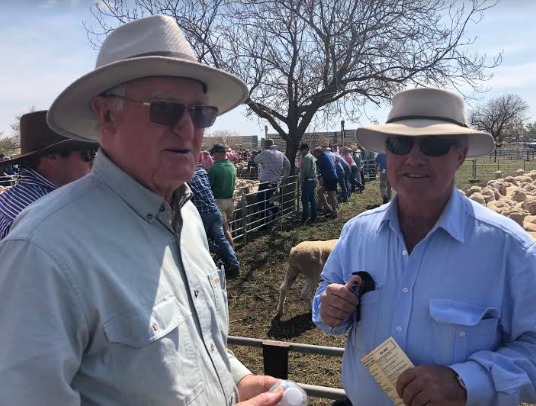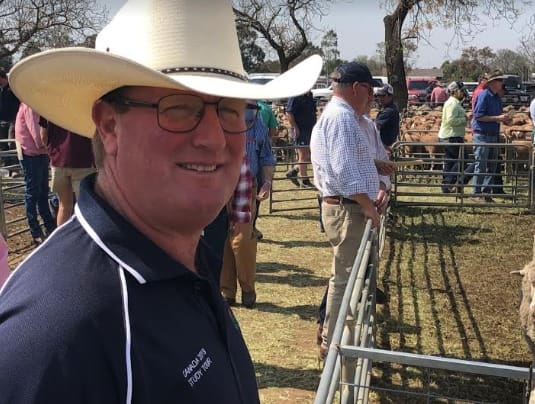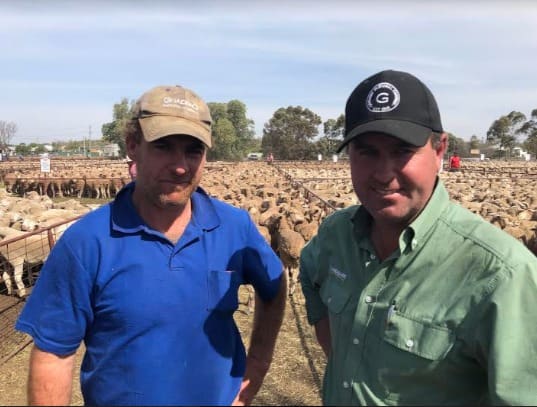A ONE-OFF eye-popping sale at $358 a head for a classy line of large-framed young Merino ewes was the icing on the cake of a remarkably consistent September sheep sale at Hay in New South Wales last Friday.
The runaway sale – a record for the Hay saleyards and possibly for Australia – stood head and shoulders clear of the sale’s next best price of $310, paid for the draft’s younger sisters.
These two market-topping lots came from a line of 800 March/April 2018 drop August shorn Alma blood ewes offered by the Rogers family, ‘Yarto’ at Booligal, NSW.
Yarto principal, Greg Rogers, described the results as good sales in an otherwise extremely tough year.
“These ewes have spent most of the past six months in a containment area eating sheep nuts.
“Apart from 100m of rain received in May, our property has survived on less the 250mm of rain over the past 26 months,” Mr Rogers told Sheep Central.
“It has cost a lot of money to get these sheep to this sale in the condition they are but we are not alone most of the other vendors presenting stock here today have been in the same boat.”

Repeat buyer Bill Bott, Correen, NSW, left, discusses with Greg Rogers, Booligal, his purchase of the Rogers family’s young Alma blood Merino ewes for $358.
The buyers of the top-ranking Yarto lines were southern Riverina crossbred specialists Bill and David Bott, ‘Emu Park’, Coreen, NSW, and Geoff and Dianne Allan, ‘Melrose’, Mathoura.

With 500 new season lambs already sold, Bendigo district lamb producer Stuart Wilson bought the opening pen of ewes at Hay, paying $295 for the young Daisy Plains ewes.
The market’s next highest price was a winning bid of $295 for 383 young Daisy Plains Alma blood ewes presented by the Bunyard family, also of Booligal.
The renowned young Goolgumbla blood Mooloomoon ewes sold for $290 as the next best priced, while most other sales of the plainer-bodied types made $250 to $285 a head.
Smaller drafts and heavier wool-cutting types were generally priced between $220 to $260 while smaller-framed, later drop and those offered in lighter condition made upwards of $180 a head.
Elders auctioneer Jason Andrews described the quality of the 40,000 strong yarding as exceptional.
“It was amazing to see how well these Hay sheep has grown and performed this year compared to other years when rainfall and conditions have been better.
“We know there has been a lot of money spent of supplementary feeding however the tops of each draft were outstanding and there was very limited tail,” Mr Andrews said.
As far as the market was concerned, Mr Andrews said prices exceeded expectation at the top of the sale, while the middle drafts were sold at about par to pre-sale thoughts.
“Middle aged ewe prices could have been a little stronger he said while aged ewes, with butcher competition have made $20/head more than in the fat pens.”
Landmark auctioneer Marc Braybon agreed with the result of the sale and said most lots in the yarding were sold to repeat buyers.
“A lot of our supplier-breeders are setting their sale lines for this sale and the buyers are returning with the confidence knowing they can purchase the type of sheep they require,” he said.
Alma Merino Stud principal, Graham Morphett from Booligal, heaped high praise on the overall result.
“It was a very consistent result across the sale.
“The younger lines, the small breeders lots and even the earlier shorn lots all made similar money (within $20) of each other which was a good result for all of our breeders,” he said.
“As breeders, our biggest concern is for next year because many of our region’s breeders didn’t join this breeding season and those that did mostly have had a poor lambing where 60 percent was a good result.”
In the sale’s preamble, selling agents Elders and Landmark cast doubt on whether the Hay sale yards would conduct another sale this spring.
“They won’t be here tomorrow or next month” they frequently called during the sale, and buyers generally responded taking most lines as they were presented and splitting only a small number of lots.
An example of this was a huge $340k-sale recorded on a large one-mark line of 1718 2015-drop Moolpa four-year-olds offered, July shorn, by Merwin Pastoral Company, Moulamein.
These were sold on a single hammer, at $192 a head, to Landmark Wagga for Bruckner family, Gnadbro, Collingully, NSW, who were topping up ewe numbers on their expansive 12,000 to 14,000- head first-cross breeding operation.
Other sales of two-to-four-year-old ewes ranged from $185 to $240 with the best, an August-shorn line of 17-drop, Charinga-blood ewes sold by Formosa, Hay while a March-shorn lot of Willow Vale ewes, same-age, Alma-blood, drew the same value.
The market for cast-for-age (2014-drop) ewes was strongly supported by the processing sector with Fletcher International Exports providing cornerstone competition. The Dubbo processor laid claim to numerous off-shears lots at $150 to $188 a head, for an estimated on-leg purchase cost of 540c/kg.
Among the leading sales of 5.5-year-olds were 800 Charinga blood Formosa ewes from Hay at $188; 550 Alma blood ewes from Minarto, Oxley, also at $188, and 350 Alma blood Yamba ewes from Booligal at $176.
In the wether lamb section, Fletchers’ Kiargathur Station feedlot, Condobolin, NSW, secured two of the opening sales, including 871 July shorn April/May 20129 drop Trida-bred, Gunbar Station blood wethers from Tiarra for $160, and 300 unshorn Alma blood wethers from Bunumburt, Oxley, for $150.
Melbourne-based processor, Wagstaff Cranbourne was another from the processing section to support the wether lamb market, purchasing 555 unshorn May/June drop Alma blood wethers from Minarto, Oxley, for $152.
Sales of unshorn wethers made to restockers were between $120 to $132, with a stand-alone sale made at $146> Tail-end and late drop lots made $66 to $116.

Wagga Wagga district buyers, Heath Bruckner, Gnadbro, Collingully, and Jarrod Slattery, Landmark, with their 1700 four year-old Moolpa and Moulamein ewes purchased at $192.
Restockers from the Wagga Wagga, Finley, Corowa, Narrandera, Griffith, Deniliquin and Temora areas were the most active among the NSW buyers, and Victorian buyers came from Yarrawonga, Echuca, Bendigo, Swan Hill, Wycheproof and Horsham.

HAVE YOUR SAY